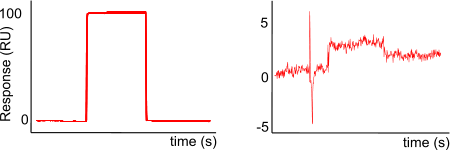Troubleshooting
Recognising problems in your experimental setup is important. Baseline drift is usually a sign of not optimal equilibrated sensor surface. It is sometimes necessary to run the flow buffer over night to equilibrate. Several buffer injections before the actual experiment can minimize drift during analyte injection. Avoid bulk shifts at the beginning and end of the injection by matching flow and analyte buffer. Low shifts (< 10 RU) due to buffer differences are easy compensated for by the reference surface but avoid larger. Sudden spikes at the beginning of the analyte injection can point to carry over. If this is observed, add extra wash steps between the injections. Take special care with high salt or high viscosity solutions.
When the response during the analyte injection is dropping it can indicate that there is sample dispersion. The sample is mixing with the flow buffer, resulting in an effective lower analyte concentration (5). Most SPR machines have special routines to separate the flow buffer from the sample. Use them and check if the sample is properly separated from the flow buffer.
Problems with carry over and sample dispersion are easily recognised by injecting an elevated NaCl solution (0.5 M) and a flow buffer solution. The NaCl solution must give a sharp rise and fall when injected have a flat steady state. The flow buffer injection should give an almost flat line indicating that the needle was sufficient washed.
